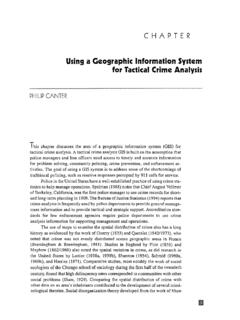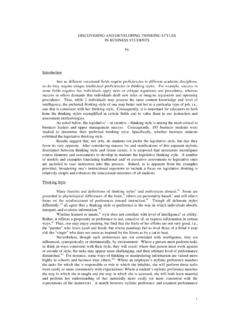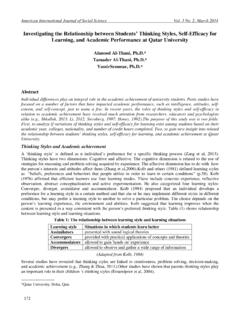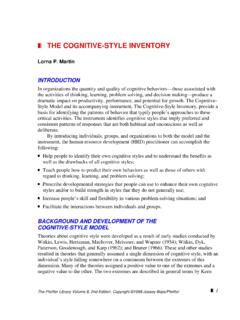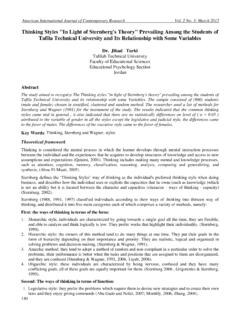Transcription of Criminal Thinking Styles Among People With Serious Mental ...
1 Criminal Thinking Styles Among People With SeriousMental Illness in JailAmy Blank Wilson, Kathleen Farkas,Karen J. Ishler, and Michael GearhartCase Western Reserve UniversityRobert MorganTexas Tech UniversityMelinda AsheCase Western Reserve UniversityThe purpose of this study was to extend the investigation of Criminal Thinking of persons with mentalillness beyond prison and community settings to a jail setting. Participants consisted of 122 individualsincarcerated in a county jail who were diagnosed with a severe Mental illness, including schizophreniaspectrum and major mood disorders. Results indicated that People with Mental illness in this sample ofjail inmates presented with Thinking Styles that support a Criminal lifestyle, and have Criminal thinkingstyles that follow a pattern that is very similar to a sample of prison inmates with Serious Mental findings support the need for therapeutic programs for justice-involved persons with seriousmental illness to develop a multipronged treatment approach that integrates interventions for individuals Criminal Thinking and antisocial attitudes with treatment for their Mental illness and substance :jail, Mental illness, mentally disordered offender, Criminal thinkingResearch has consistently demonstrated that People with seriousmental illness (SMIs) are substantially overrepresented in thecriminal justice system (Ditton, 1999;Steadman, Osher, Robbins,Case, & Samuels, 2009;Teplin, Abram, & McClelland, 1996).
2 Estimates of the prevalence of People with Mental illness in jailsvary based on study methodology, setting, and definition of mentalillness (Steadman et al., 2009). However, even studies that haveused the most conservative and empirically defensible measures(Steadman et al., 2009;Teplin, 1990;Teplin et al., 1996) havefound that to of men and to of women injails have an SMI. These estimates mean that a staggering numberof People with SMI are housed in jails across the United States,given that jails admit over 12 million People each year and releasealmost 9 million (Spaulding et al., 2009).Recognition Among policymakers of the presence of large num-bers of People with Mental illness in jails and prisons has led tounprecedented service development for these clients at the federal,state, and local levels. These services, recently termed first gen-eration services (Epperson et al., 2011), were designed to reducecriminal justice involvement by targeting various aspects of con-sumers Mental illness.
3 They include programs such as pre- andpostjail diversion services (Broner, Lattimore, Cowell, & Sch-lenger, 2004;Compton, Bahora, Watson, & Olivia, 2008), reentryservices (Draine & Herman, 2007;Osher, Steadman, & Barr,2003), specialty community supervision caseloads (probation orparole;Skeem, Peterson, & Silver, 2011), and Mental health courts(Boothroyd, Mercado, Poythress, Christy, & Petrila, 2005;Cos-den, Ellens, Schnell, & Yamini-Diouf, 2005). Although there aredifferences in the structure and emphasis of each service model,none have been able to achieve a consistent impact on participants future involvement in Criminal justice settings (Epperson et al.,2011;Morrissey, Meyer, & Cuddeback, 2007;Osher & Steadman,2007;Steadman & Naples, 2005). These findings suggest thatsomething is missing in our current approach to providing treat-ment to this client population (Fisher & Drake, 2007).Some of the most prominent efforts to explain why mentalhealth treatment programs have struggled to impact public safetyoutcomes focus on identifying what is missing from current treat-ment approaches.
4 One explanation for this lack of impact focuseson the fact that these services do not provide treatment thataddresses risk factors for recidivism (Skeem & Louden, 2006).Another points to the lack of availability of evidence-based mentalhealth treatments for People with Mental illness involved in thecriminal justice systems (Osher & Steadman, 2007;Steadman &Naples, 2005). However, a growing body of evidence has foundthat there is no guarantee that access to evidence-based mentalhealth practices will have a significant impact on participants This article was published Online First April 7, Blank Wilson, Kathleen Farkas, Karen J. Ishler, and MichaelGearhart, Jack, Joseph and Morton Mandel School of Applied SocialSciences, Case Western Reserve University; Robert Morgan, PsychologyDepartment, Texas Tech University; Melinda Ashe, School of Arts andSciences, Case Western Reserve work was funded in part by a Second Chances Grant from the of concerning this article should be addressed to AmyBlank Wilson, Jack, Joseph and Morton Mandel School of Applied SocialSciences, Case Western Reserve University, 10900 Euclid Ave.
5 , Cleve-land, OH 44106. document is copyrighted by the American Psychological Association or one of its allied article is intended solely for the personal use of the individual user and is not to be disseminated and Human Behavior 2014 American Psychological Association2014, Vol. 38, No. 6, 592 6010147-7307/14/$ justice outcomes (Morrissey et al., 2007;Osher & Stead-man, 2007;Skeem et al., 2011;Steadman & Naples, 2005).These discussions have led some to suggest that treatmentprotocols for evidence-based Mental health practices for peoplewith Mental illness involved in the Criminal justice system need tobe modified to include interventions capable of addressing the riskfactors associated with Criminal conduct (Morrissey et al., 2007).However, little is known about the nature or extent of criminogenicrisk in this population. The recent attention given to the role thatcriminogenic risk factors may be playing in the Criminal involve-ment of People with SMI ( ,Epperson et al.)
6 , 2011) has led to thesuggestion that these risk factors, which include antisocial think-ing, behaviors, attitudes, and associates (Andrews, Bonta, &Wormith, 2006), are important co-occurring problems Among peo-ple with SMI involved in the justice system. If this hypothesis iscorrect, then finding treatments for these risk factors represents thenext frontier in the development of services for this client popu-lation (Epperson et al., 2011).Bonta, Law, and Hanson (1998)conducted one of the earlieststudies that looked at the nature of criminogenic risk Among peoplewith Mental illness. This study used meta-analytic techniques tocompare the predictors of recidivism for People with Mental illnesswith those of non-ill offenders. This analysis found that the majorrisk factors for recidivism were the same for People with mentalillness and offenders without Mental illness. For example, thestrongest predictors of recidivism Among both groups were foundto be criminogenic risk factors associated with the person s crim-inal history ( , the frequency and onset of past Criminal behav-ior), whereas clinical variables (any treatment for Mental illness)were the weakest.
7 A follow-up meta-analysis produced similarresults: Common Criminal risk factors are as relevant for offenderswith Mental illness as they are for their nonmentally ill counter-parts, and Criminal risk factors remain better predictors of criminaloutcomes than clinical factors (Bonta, Blais, & Wilson, 2013).Although this research offers strong support for the presence ofcriminogenic risk factors Among People with Mental illness, thestatic nature of the risk factors identified in these studies does littleto inform the development of treatment addition to theBonta et al. (1998,2013) meta-analyses, otherresearch has supported the assertion that People with SMI face anumber of criminogenic risk factors. For example, research onadults with schizophrenia has found that they have higher rates ofchildhood conduct disorders than People in the general population(Mueser et al., 2006;Robins, 1993). Epidemiological studies havealso found an association between SMIs, such as schizophrenia,and antisocial personality disorder (Moran & Hodgins, 2004).
8 Information such as this is helpful in developing a clinical profileof People with Mental illness involved in the Criminal justicesystem. Here again, however, the static nature of identified riskfactors does little to advance the development of interventions;regardless of the focus or intent of an intervention, these factorscannot be recent studies have examined the presence of dynamiccriminogenic risk factors Among People with SMI in prisons (Mor-gan, Fisher, Duan, Mandracchia, & Murray, 2010;Wolff, Morgan,& Shi, 2013;Wolff, Morgan, Shi, Fisher, & Huening, 2011). Thesestudies focused on Criminal Thinking and antisocial attitudes, whichrepresent two critical areas of criminogenic risk. Criminal thinkingis important, in part because it is a dynamic risk factor amenableto intervention (Friendship, Blud, Erikson, Travers, & Thornton,2003;Walters, Trgovac, Rychlec, Di Fazio, & Olson, 2002). It isalso one of the four criminogenic risk factors that are believed tohave the biggest impact on offending behaviors (Andrews et al.)
9 ,2006).Morgan et al. (2010)conducted one of the first studies thatassessed the prevalence of Criminal Thinking Among justice-involved People with Mental illness. Criminal Thinking and anti-social attitudes were assessed in 283 prison inmates (178 men, 105women) with Mental illness. This study used the Criminal Senti-ment Scale-Modified (CSS-M;Simourd, 1997) to assess antisocialattitudes. The study found that 85% of men and 72% of women inthe study held antisocial attitudes, values, and beliefs related tocrime. In addition, compared with a sample of offenders withoutmental illness, study participants had higher scores on all CSS-Msubscales, except identification with Criminal others (Morgan etal., 2010).The second measure used byMorgan et al. (2010)to assesscriminal Thinking Among People with SMI was the PsychologicalInventory of Criminal Thinking Styles (PICTS;Walters, 1995,2006). This measure was designed to assess the extent to whichparticipants engaged cognitive Thinking patterns associated withserious Criminal behavior.
10 This measure identifies elevated levelsof Criminal Thinking using gender-specific normative scores. Mor-gan et al. s analysis found that 66% of their sample endorsed athinking style that indicated the presence of a belief system thatwas supportive of a Criminal lifestyle. Furthermore, when Morganet al. examined the average scores on the Thinking scales for menand women, only two scales were elevated to a level of clinicalsignificance. Both the Cutoff and Discontinuity scales, whichassessed impulsivity and lack of focus, were elevated to clinicallysignificant levels Among men in the sample. Further analysis ofindividual scores found that 71% of individuals had an elevatedscore on at least one Criminal Thinking et al. (2011)also examined antisocial attitudes amongpeople with Mental illness incarcerated in prison. In this study,readiness for reentry Among 4,204 inmates was assessed using acomputer-assisted, self-administered survey that also used theCSS-M (Simourd, 1997) to assess antisocial et al.



